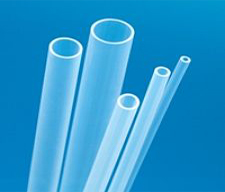Fluorinated ethylene propylene or FEP is a copolymer of hexafluoropropylene and tetrafluoroethylene. It differs from the PTFE (polytetrafluoroethylene) resins in that it is melt-processible using conventional injection molding and screw extrusion techniques. Fluorinated ethylene propylene was invented by DuPont and is sold under the brandname Teflon FEP. Other brandnames are Neoflon FEP from Daikin or Dyneon FEP from Dyneon/3M.
FEP is a relatively soft thermoplastic produced by the copolymerization of tetrafluoroethylene and hexafluoropropylene. Despite its softness, FEP is chemically inert and has a low dielectric constant over a wide frequency range. It offers a very high degree of stress-crack resistance, a low coefficient of friction, exceptional dielectric properties and heat resistance. FEP retains its properties at temperatures ranging from -454° F to 400° F. FEP is highly transparent, with good transmittance of ultraviolet and visible wavelengths. It weathers well over the long term and has excellent resistance to ozone and sunlight. Its refractive index is the lowest of all thermoplastics, and its light reflection is low (the same as water). FEP also meets FDA specification 21CFR.177.1550 and is USP Class VI approved. Typical FEP applications include linings for pipe and chemical processing equipment, roll covers, aircraft wire, plenum cable, fire alarm cable, and well logging cable. FEP is mainly used for wiring, e.g.,hookup wire, coaxial cable, wiring for computer wires and technical gear. An illustrative end product is for Co-axial cables like RG-316.
Due to its flexibility, extreme resistance to chemical attack and optical transparency, this material, along with PFA is routinely used for plastic labware and tubing that involves critical or highly corrosive processes. Brand GmbH, Finemech, Savillex and Nalgene are well known laboratory suppliers that makes extensive use of the two materials.
FEP is very similar in composition to the fluoropolymers PTFE (polytetrafluoroethylene) and PFA (perfluoroalkoxy polymer resin). FEP and PFA both share PTFE's useful properties of low friction and non-reactivity, but are more easily formable. FEP is softer than PTFE and melts at 260 °C; it is highly transparent and resistant to sunlight. In manufacturing high-quality composite parts, such as in the aerospace industry, FEP film can be used to protect molds during the curing process. In such applications, the film is called "release film" and is intended to prevent the curing adhesive polymer (e.g. the epoxy in a carbon fibre/epoxy composite laminate) from bonding to the metal tooling. One example is the A-5000 FEP release film by Richmond Aircraft Products.
TeflonFEP is a fluorinated ethylene propylene resin that meets the ASTM Standard Specification for FEP—Fluorocarbon Molding and Extrusion Materials under ASTM Designation D2116-95a. It is available as pellets or as stabilized aqueous dispersions. Applications for this family of resins include coating, melt extrusion, and impregnating. Products made from TeflonFEP are known for their excellent chemical resistance, superior electrical properties, and high service temperatures of up to 200°C (392°F). In addition, TeflonFEP provides outstanding low-temperature toughness and unique flame resistance.
TeflonFEP fluoroplastic resins are processed by conventional melt-extrusion techniques and by injection, compression, transfer, and blow-molding processes.The high melt strength and draw-down capability of these resins facilitate the use of large dies and draw-down tooling to increase production rates. Equipment in contact with molten resin should be made of corrosion-resistant metals.
Larger length-over-diameter extruder barrels are used to provide enough residence time at high production rates to melt these high-temperature polymers. Reciprocating screw injection molding machines are recommended.
Key Properties
Chemically inert
Resistant to ozone, ultraviolet light and weather
Low refractive index
FDA approved
Highly transparent
Standard Shapes and Forms
Sheet: .03125” – 2” thick
Rod: .125” – 6” diameter
Other Forms: Flexible Tubing, Heat Shrink Tubing, Welding Rod, Roll Covers and Film
FEP (fluorinated ethylene propylene) Pictures








 Member
Member